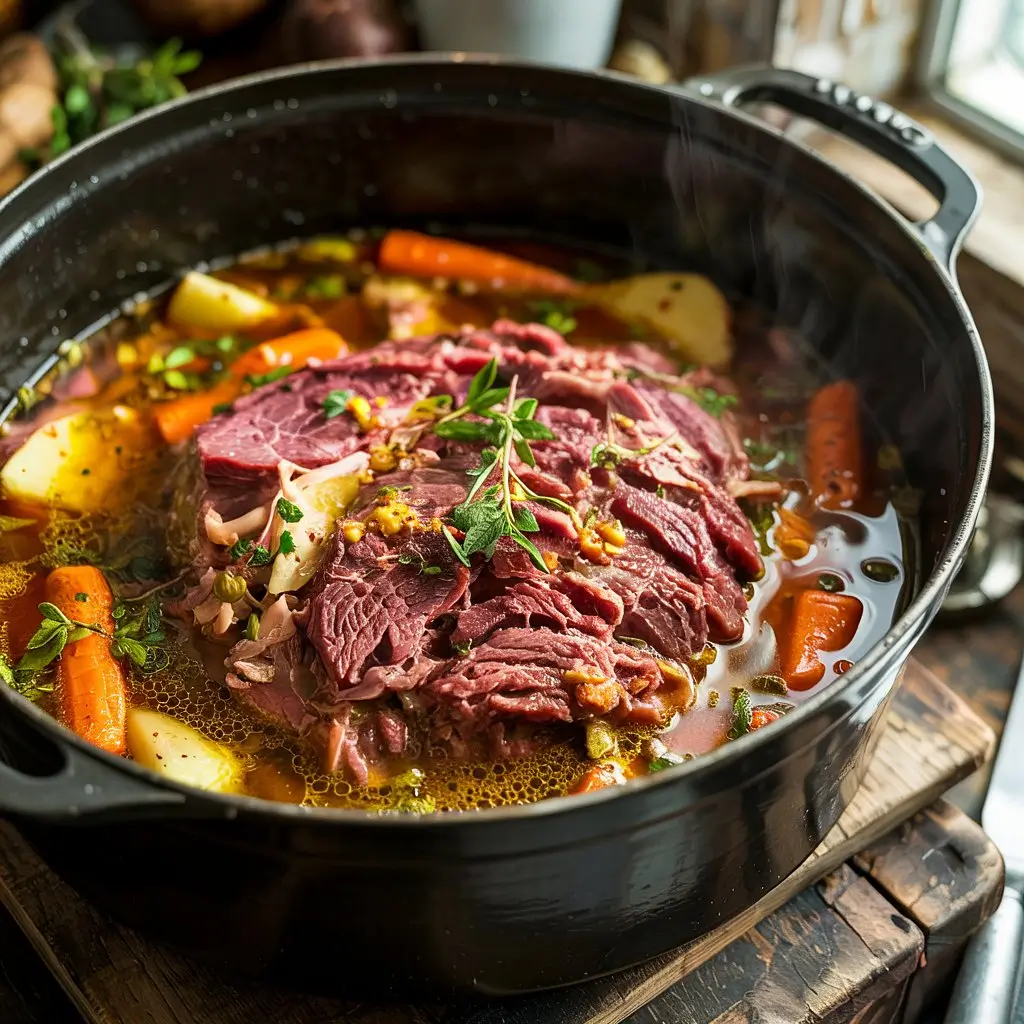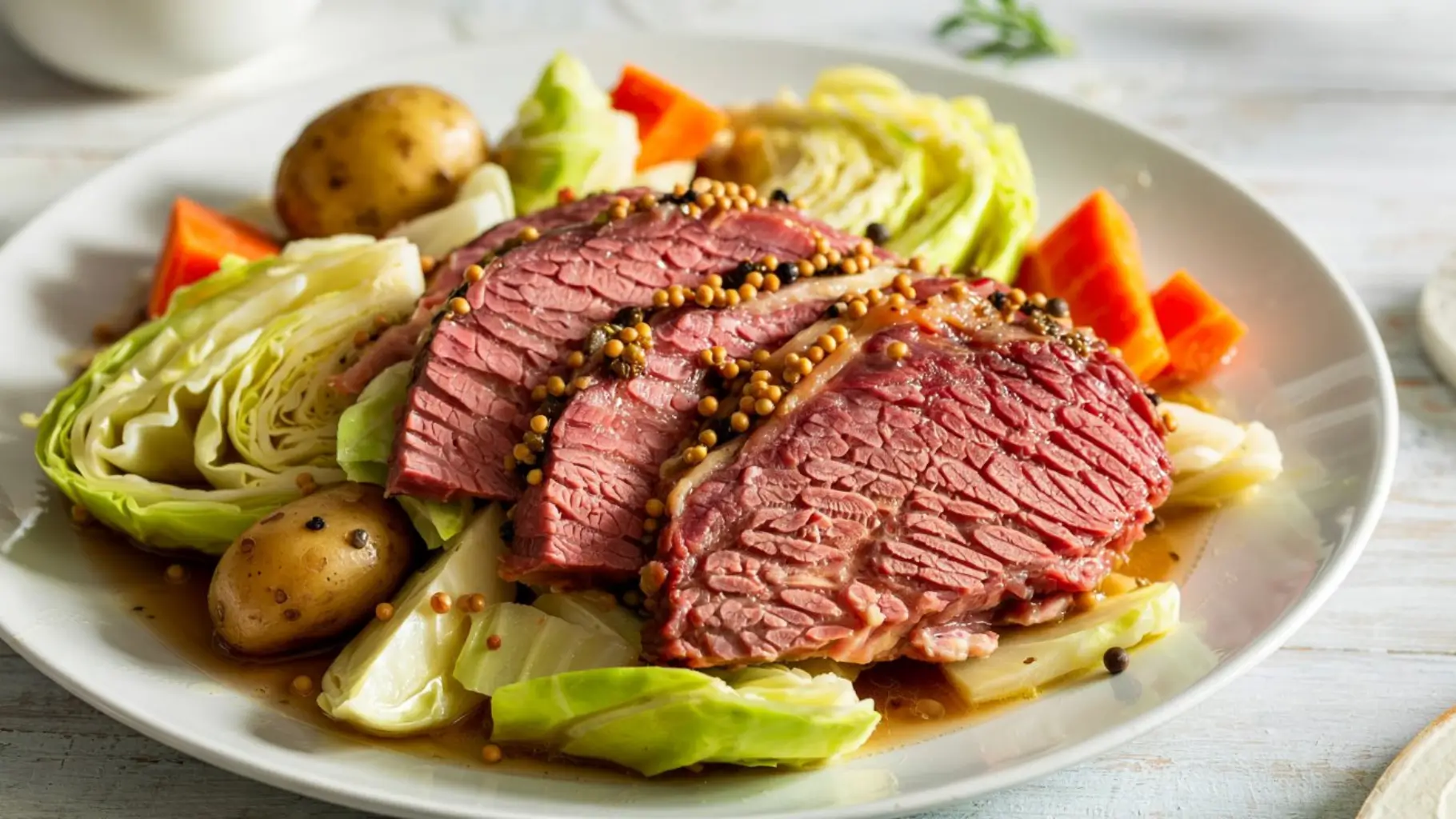Table of Contents
Introduction
Corned beef and cabbage is a beloved dish with deep roots in Irish-American tradition, often served on St. Patrick’s Day as a hearty, flavorful meal. Despite its Irish associations, this dish became popular in the U.S. as immigrants adapted their cuisine using affordable ingredients like salt-cured beef brisket and cabbage.Learn more about its history in this Smithsonian Magazine article.
The star of the dish—tender corned beef—is slowly simmered with aromatic spices, resulting in a rich, savory flavor. Paired with buttery cabbage, carrots, and potatoes, it’s a satisfying one-pot meal that’s both comforting and easy to prepare.
Beyond tradition, this dish offers protein-packed beef and fiber-rich vegetables, making it a balanced option for family dinners. The slow cooking process ensures fork-tender meat, while the cabbage absorbs the delicious broth for extra depth.
Whether you’re celebrating St. Patrick’s Day or simply craving a classic comfort meal, this corned beef and cabbage recipe delivers timeless taste with minimal effort. Let’s get cooking!
Ingredients for Corned Beef and Cabbage Recipe
This classic dish comes together with simple, flavorful ingredients that meld together during cooking. For guidance on selecting quality meats, refer to USDA beef handling guidelines.
You’ll need both the corned beef brisket with its signature spice packet and fresh vegetables to create that perfect balance of savory meat and tender, slightly sweet cabbage.

Main Ingredients:
- 3-4 lbs corned beef brisket (flat or point cut), with spice packet
- 1 large head green cabbage, cut into wedges
- 1 lb baby potatoes or red potatoes, halved
- 4 medium carrots, peeled and cut into chunks
Cooking Liquid & Seasonings:
- 4 cups water or beef broth (for richer flavor)
- 3 garlic cloves, smashed
- 1 bay leaf
- 1 tbsp whole peppercorns
- 1 tbsp mustard seeds (optional)
- 1 tbsp brown sugar (optional, for subtle sweetness)
For Serving (Optional):
- Whole-grain mustard
- Fresh parsley, chopped
- Crusty bread or Irish soda bread
Note: If your corned beef doesn’t include a spice packet, use a mix of 1 tsp coriander seeds, 1/2 tsp allspice berries, and 1/2 tsp mustard seeds as a substitute.
This straightforward ingredient list ensures a tender, well-seasoned corned beef with perfectly cooked vegetables—no complicated steps required. Next, we’ll walk through the simple cooking process.
How to Make Corned Beef and Cabbage
This reliable method ensures melt-in-your-mouth corned beef and perfectly tender vegetables every single time.. You can prepare it on the stovetop, in a slow cooker, or using an Instant Pot—choose what works best for you!, For science-based cooking techniques, visit America’s Test Kitchen.

Stovetop Method (Dutch Oven):
- Prep the Beef: Rinse the corned beef under cold water to remove excess salt. Place it in a large Dutch oven along with the spice packet, garlic, bay leaf, peppercorns, and enough water or broth to cover by 1 inch.
- Simmer: Bring to a boil, then reduce heat to low. Cover and simmer for 2.5–3 hours (about 50 minutes per pound), or until the beef is tender when pierced with a fork.
- Add Vegetables:
- Potatoes & Carrots: Add them to the pot during the last 30 minutes of cooking.
- Cabbage: Add wedges during the last 15 minutes to prevent overcooking.
- Rest & Serve: Transfer the beef to a cutting board, slice against the grain, and serve with vegetables and a ladle of broth.
Slow Cooker Method:
- Layer the corned beef, spices, and garlic in the slow cooker. Add water/broth to cover.
- Cook on Low for 8–9 hours or High for 5–6 hours.
- Add potatoes and carrots in the last 2 hours, and cabbage in the last 30 minutes.
Instant Pot Method:
- Place the beef, spices, and 2 cups of broth/water in the pot.
- Cook on High Pressure for 90 minutes, then natural release for 15 minutes.
- Add vegetables, seal again, and cook on High Pressure for 3 minutes. Quick release, then serve.
Pro Tip: For extra flavor, sear the beef in a hot pan before cooking
Serving Suggestions
Corned beef and cabbage is a complete meal on its own, but these simple pairings can take your dish to the next level:

Classic Pairings:
- Crusty Bread or Irish Soda Bread – Perfect for soaking up the flavorful broth.
- Whole-Grain Mustard or Horseradish Sauce – Adds a tangy kick to balance the richness.
- Buttered Parsley Potatoes – Toss boiled potatoes with melted butter and fresh parsley.
For Leftovers (Next-Day Meals):
- Reuben Sandwich – Layer sliced corned beef, Swiss cheese, sauerkraut, and Russian dressing on rye bread.
- Corned Beef Hash – Pan-fry diced potatoes, onions, and chopped corned beef until crispy. Top with a fried egg.
- Cabbage Soup – Simmer leftover cabbage and broth with tomatoes, carrots, and herbs.
Presentation Tips:
- Cut the beef across the grain to ensure it’s as tender as possible.
- Arrange cabbage wedges, carrots, and potatoes around the beef for a rustic family-style meal.
- Sprinkle with fresh parsley to add a vibrant touch of color.
This dish pairs well with a cold Irish stout or apple cider for a true pub-style experience.
Tips & Variations for the Best Corned Beef and Cabbage
Take your dish from good to exceptional with these expert tips and creative twists:
Essential Tips:
✔ Rinse the beef before cooking to remove excess salt from the curing process.
✔ Keep the simmer gentle—a rapid boil can make the meat tough.
✔ Slice against the grain for tender bites (look for the muscle fibers’ direction).
✔ Cook cabbage separately if you prefer crisp-tender texture (add to broth just before serving).
✔ Save the cooking liquid—it makes a flavorful base for soups or reheating leftovers.
Flavor Variations:
- Sweet & Tangy: Add ¼ cup apple cider vinegar + 2 tbsp honey to the broth.
- Spicy Kick: Toss in 1 tsp red pepper flakes or a sliced jalapeño.
- Beer-Braised: Substitute half the water with a malty Irish stout or lager.
Dietary Adaptations:
- Low-Sodium: Use homemade brine or soak store-bought corned beef in water for 1 hour before cooking.
- Gluten-Free: Ensure the spice packet is GF, or make your own blend.
- Vegetarian Twist: Replace beef with thick-cut portobello mushrooms or tempeh, using the same spices.
Alternative Cooking Methods:
- Oven-Roasted: Wrap spiced beef in foil with 1 cup broth; bake at 300°F for 4 hours. Add veggies halfway.
- Grilled: Slice cooked corned beef thickly, brush with mustard glaze, and char on high heat for 2 minutes per side.
Pro Tip: For deeper flavor, refrigerate the cooked beef in its broth overnight, then reheat gently before serving.
Nutritional Profile of Corned Beef and Cabbage
This traditional dish offers substantial protein and nutrients, though its salt content requires some consideration. This hearty dish provides a balance of protein, vitamins, and minerals. Detailed nutritional data is available at USDA FoodData Central.
Here’s what you’re getting in each serving (assuming 6 portions):
Macronutrient Breakdown
- Energy: Approximately 475 calories per serving
- Protein Powerhouse: 32g (over half your daily need)
- Smart Carbs: 28g (mostly complex carbs from veggies)
- Dietary Fiber: 6g (25% of daily requirements)
- Fat Content: 22g (includes 8g saturated fat)
Key Micronutrients
- Iron Boost: Provides 18% DV (from the beef)
- Immune Support: 45% DV vitamin C (mainly from cabbage)
- Blood Pressure Helpers: 22% DV potassium (balances sodium effects)
- B Vitamin Complex: Especially rich in B12 (51% DV)
Sodium Awareness
Prepared corned beef typically ranges between 850-1250mg sodium per portion. Health-conscious cooks can:
- Soak the beef in cold water for 1 hour pre-cooking
- Select low-sodium broth alternatives
- Increase vegetable proportions to dilute sodium impact
Nutrition Optimization Tips:
- Double the cabbage for extra vitamin K
- Include purple potatoes for antioxidants
- Serve with lemon wedges to enhance iron absorption
- Reserve some cooking liquid for a lower-sodium soup base later
Frequently Asked Questions
1. What’s the best way to cook corned beef?
For the most tender results, low and slow cooking is key. Simmering on the stovetop (2.5–3 hours), using a slow cooker (8–9 hours on low), or pressure cooking (90 minutes in an Instant Pot) all work well. Always slice against the grain for maximum tenderness.
2. How is corned beef made?
Corned beef is made by salt-curing beef brisket with a brine (traditionally containing salt, sugar, and spices like peppercorns and bay leaves). Store-bought versions come pre-brined, but you can make your own with a 5–7 day soak in a seasoned brine.
3. Why is corned beef and cabbage so popular?
While often associated with Irish-American tradition, this dish became popular because cabbage and potatoes were affordable vegetables that paired well with inexpensive, preserved beef. It’s now a St. Patrick’s Day staple in the U.S.
4. When should I add cabbage to corned beef?
Add cabbage in the last 15–20 minutes of cooking to keep it tender but not mushy. If using a slow cooker or Instant Pot, add it at the very end to avoid overcooking.
5. Is corned beef and cabbage an American dish?
Yes! While Ireland has a history of salt-cured meats, the specific pairing with cabbage became popular among Irish immigrants in America, who adapted their cooking to local ingredients.
6. Can I freeze leftover corned beef?
Absolutely! Store sliced beef in an airtight container with some cooking liquid for up to 3 months. Thaw in the fridge before reheating.
7. What’s the best cut for corned beef?
Brisket (either flat or point cut) is traditional. Flat cut is leaner and slices neatly, while point cut has more marbling for richer flavor.
8. What’s the healthiest way to prepare corned beef?
Rinse the beef before cooking to reduce sodium.
Use low-sodium broth.
Load up on extra cabbage and carrots for fiber.
Trim excess fat before serving.
Conclusion & Call to Action
Few meals balance tradition and flavor as perfectly as corned beef and cabbage. This humble yet satisfying combination turns basic ingredients into something extraordinary through slow cooking and thoughtful seasoning.
What Makes This Dish Special:
- Adaptable Preparation – Works beautifully whether you choose stovetop, slow cooker, or pressure cooker methods
- Economical Ingredients – Transforms an affordable cut of meat into a centerpiece-worthy meal
- Endless Possibilities – Leftovers inspire creative next-day meals from breakfast hash to hearty sandwiches
Chef’s Recommendation: Allow the cooked beef to sit in its cooking liquid for about 15 minutes before carving. This simple step ensures each slice remains moist and full of flavor.
We invite you to experience this timeless recipe for yourself. Adjust the spices to your taste, experiment with cooking times, and most importantly – enjoy the process. Share your version of this classic dish with friends and family.
Ready to begin your culinary journey? Gather your ingredients and start cooking today!


3 thoughts on “How to Make Amazing Corned Beef and Cabbage – A Flavor-Packed Tradition!”